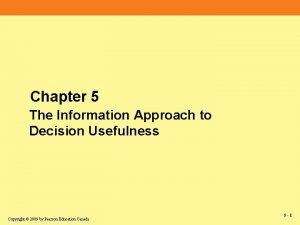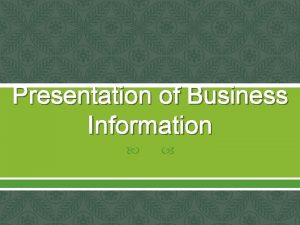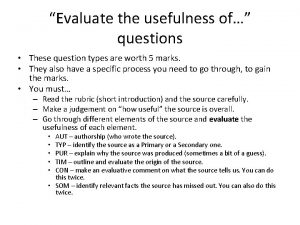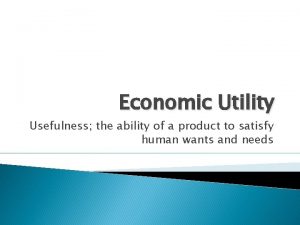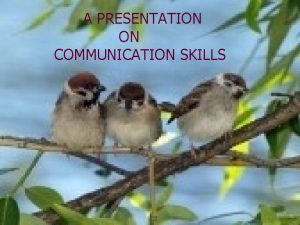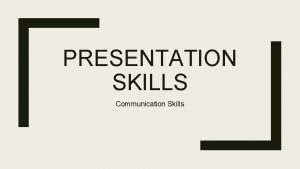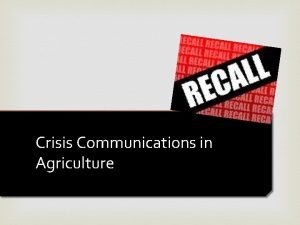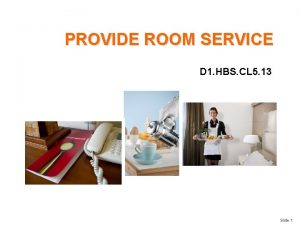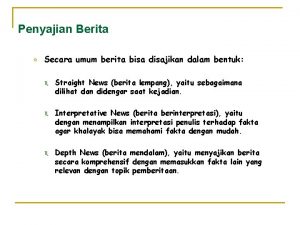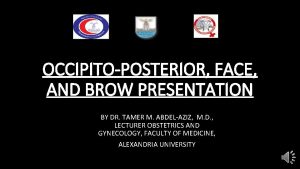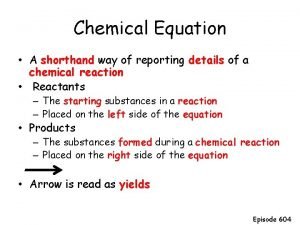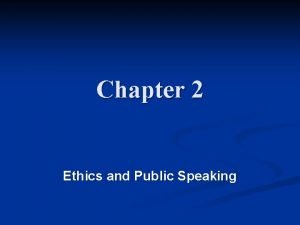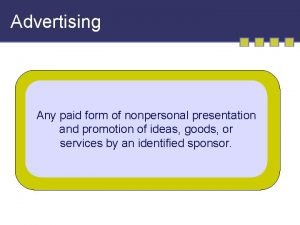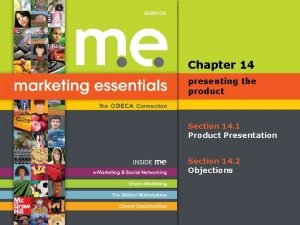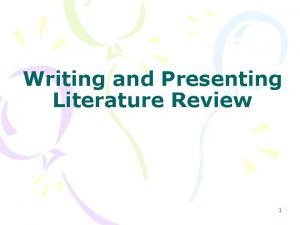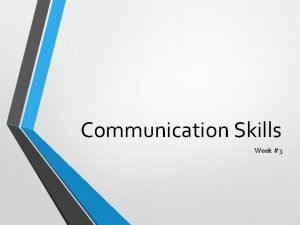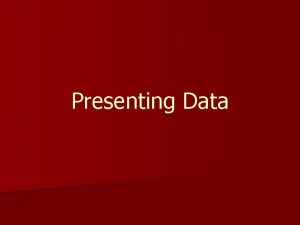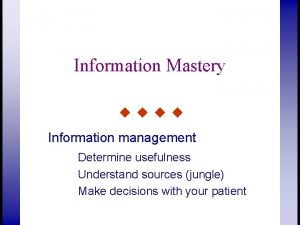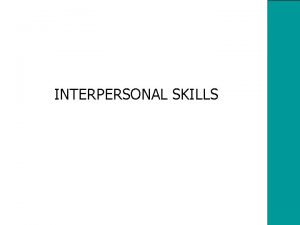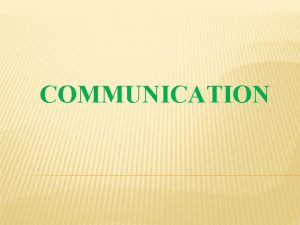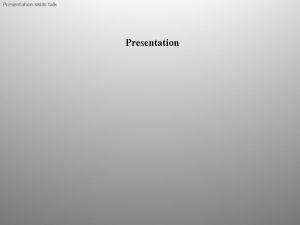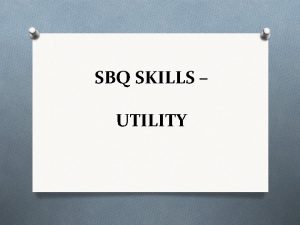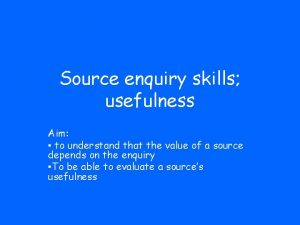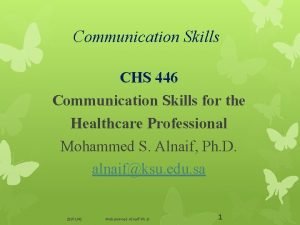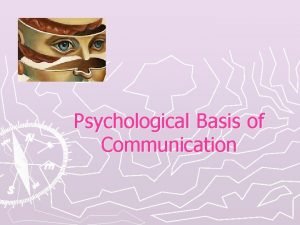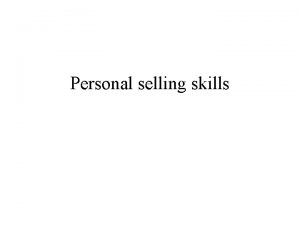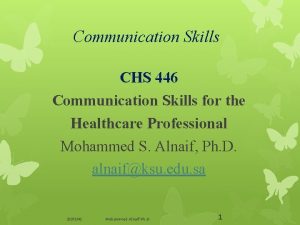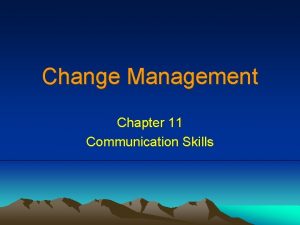Communication Skills Lecture 4 Presentation Usefulness Presenting information































- Slides: 31

Communication Skills Lecture 4

Presentation: Usefulness • Presenting information clearly and effectively is a key skill to get your message or opinion across and, today, presentation skills are required in every field. • • Whether you are: a student, administrator or executive, if you wish to start up your own business, apply for a grant or stand for an elected position, – you may very well be asked to make a presentation.

What is a Presentation? • “A presentation is a means of communication that can be adapted to various speaking situations, such as talking to a group, addressing a meeting or briefing a team. ” • To be effective, step-by-step preparation and the method and means of presenting the information should be carefully considered. • A presentation requires you to get a message across to the listeners and will often contain a 'persuasive' element. It may, for example, • be a talk about the positive work of your organization, • what you could offer an employer, • or why you should receive additional funding for a project.

Presentation: Key Elements • Context • When and where will you deliver your presentation? • There is a world of difference between a small room with natural light and an informal setting, and a huge lecture room, lit with stage lights. The two require quite different presentations, and different techniques. • Will it be in a setting you are familiar with, or somewhere new? • If somewhere new, it would be worth trying to visit it in advance, or at least arriving early, to familiarize yourself with the room. • Will the presentation be within a formal or less formal setting? • A work setting will, more or less by definition, be more formal, but there also various degrees of formality within that.

Presentation: Key Elements • Context • Will the presentation be to a small group or a large crowd? • Are you already familiar with the audience? • With a new audience, you will have to build rapport quickly and effectively, to get them on your side. • What equipment and technology will be available to you, and what will you be expected to use? • In particular, you will need to ask about microphones, multimedia and whether you will be expected to stand in one place, or move around. • What is the audience expecting to learn from you and your presentation? • This will give you clues as to what information needs to be included in your presentation.

Presentation: Key Elements • Presenter • The role of the presenter is to communicate with the audience and control the presentation. • Remember, though, that this may also include handing over the control to your audience, especially if you want some kind of interaction.

Presentation: Key Elements • Audience • The audience receives the presenter’s message(s). • However, this reception will be filtered through • and affected by such things as the listener’s own experience, knowledge and personal sense of values.

Presentation: Key Elements • Message • The message is delivered not just by the spoken word (verbal communication) • but can be augmented by techniques such as voice projection, body language, gestures, eye contact (non-verbal communication), and visual aids. • The message will also be affected by the audience’s expectations. • For example, if you have been asked to present on one particular topic, and you choose to speak on another, the audience is unlikely to take your message on board even if you present very well. • They will judge your presentation a failure, because you have not met their expectations.

Presentation: Key Elements • Reaction • The audience’s positive reaction will largely depend upon whether the presenter effectively communicated the message or not. • As a presenter, you don’t control the audience’s expectations.

Presentation: Key Elements • Method • Presentations are usually delivered direct to an audience. • However, there may be occasions where they are delivered from a distance over the Internet using video conferencing systems, such as Skype. • It is also important to remember that if your talk is recorded and posted on the internet, then people may be able to access it for several years. • This will mean that your contemporaneous references should be kept to a minimum.

Presentation: Key Elements • Impediments • • • For example, background noise or other distractions, an overly warm or cool room, or the time of day and state of audience’s alertness can all influence your audience’s level of concentration. • As presenter, you have to be prepared to cope with any such problems and try to keep your audience focused on your message.

Four Cornerstones of a Successful Presentation • “You may have the best idea, the best product or best plan. However, if you cannot present it in a professional manner it may never be recognized as valuable. ” • Louis De. George

Know Your Audience • Why is it important to know your audience? • Knowing your audience allows the speaker to determine what and how he needs to present.

Know Your Audience • The speaker can demonstrate concern for the audience’s interests • and greatly enhance the effectiveness of a presentation • by gathering pertinent information about the audience • and tailoring the presentation accordingly.

Know Your Audience

Know Your Audience • Here are some ways to gather information about your audience: Talk with members of the audience beforehand Distribute a survey before the presentation Talk with the organizer Review evaluations from past presentations Attend a presentation before yours to get a sense of what the group is like • Ask for information or written materials that describe the audience • • •

Know Your Purpose • Decide whether the main purpose of your talk is to… • Provide information (increase awareness) • Change attitudes (create emotion) • Build new skills (training activities)

Know Your Purpose • Informational (provide information) – • The purpose of an informational speech is to inform the audience about a specific topic or issue. • For example, a speaker may want to inform the clinical staff of the Ministry of Health’s 5 -year plan.

Know Your Purpose • Motivational (change attitudes) – • The purpose of a motivational speech is to interest the audience in your topic and motivate them to take action. • Inspire your audience to make a change by using personal and emotional appeals. • For example, the speaker might tell a story about a child killed in a car accident to motivate the audience to pass laws regarding the need for child safety seats.

Know Your Purpose • Motivational (change attitudes) – • The purpose of a motivational speech is to interest the audience in your topic and motivate them to take action. • Inspire your audience to make a change by using personal and emotional appeals. • For example, the speaker might tell a story about a child killed in a car accident to motivate the audience to pass laws regarding the need for child safety seats.

Know Your Purpose • Demonstration (build new skills) – • The purpose of a demonstration speech is to teach the audience something new. • For example, today you are learning techniques for delivering a more effective presentation.

Know Your Purpose • Extemporaneous – • An extemporaneous speech is when a person is asked to speak without preparation. • For example, at the beginning of this class you all were asked to speak about yourself.

Know Your Material • One way to increase your confidence as a speaker is to know where your content information is coming from (know your source). • Conduct research on the topic • Use content information from credible sources • Incorporate data/statistics that are relevant to the audience • List some resources that will be helpful to the audience

Know Your Self • Part of knowing yourself as a speaker is knowing: • Your Style: The speaking or presentation style you are comfortable with. • Your Skills/Strengths: Pertaining to presenting (such as: humor, ability to build rapport with listeners, graphical design, etc. ) • Your Weaknesses

Activity • Which of the following is a myth about presenting? • A. A great presentation requires planning. • B. Good speakers are all naturals. • C. Constructive criticisms are not the best ways to improve. • D. Never videotape yourself presenting.

Activity • Correct Answer: B. Good speakers are all naturals. • Speaking well is an art which can be learned through knowledge, practice and experience. • For the same reason, we are all gathered here to learn communication skills.

Activity • Which of the following statements is false? • A. Most professional institutions and workplaces emphasize on teams. • B. We are currently in the information age, learning how to communicate has never been so prevalent. • C. Presentation skills can't lead to work advancements. • D. Hierarchies in professional institutions are becoming more interactive and participatory.

Activity • Correct Answer: C. Presentation skills can't lead to work advancements. • A good presenter has the ability to impress and motive others. • He/she will definitely be deemed as an apt person for promotion if he/she displays useful communication skills to his/her employers.

Activity • You work for an airline corporation that emits high levels of CO 2 each year. You are aware of the latest eco-friendly technologies. In a presentation, how can you improve your chances of engaging your CEO? • A. Use basic facts and figures. • B. Use stories that can trigger an emotional response. • C. Have a prize at the end of your presentation. • D. Dress well.

Activity • Correct Answer: B. Use stories that can trigger an emotional response. • The topic requires a humanitarian spirit and hence, the presenter will need to activate an emotional response from the targeted audience.

Let’s Summarize • • • Presentation Key Elements Context Presenter Audience Message Reaction Method Impediments • Four Cornerstones of Successful Presentations • Know Your Audience • Know Your Purpose • Know Your Material • Know Your Self
 Information approach to decision usefulness
Information approach to decision usefulness Different methods of presenting information
Different methods of presenting information Presentation and data response
Presentation and data response How to answer source based questions in history
How to answer source based questions in history Evaluate the usefulness
Evaluate the usefulness Place utility examples
Place utility examples Decision usefulness approach
Decision usefulness approach Harmful material
Harmful material Diaphorisis
Diaphorisis Presentation on communication skills
Presentation on communication skills Lack of presentation skills
Lack of presentation skills 01:640:244 lecture notes - lecture 15: plat, idah, farad
01:640:244 lecture notes - lecture 15: plat, idah, farad Lecture presentation software
Lecture presentation software Crisis communications lecture
Crisis communications lecture Business communication lecture slides
Business communication lecture slides Healthmis.ng
Healthmis.ng The physical outline of a display
The physical outline of a display Room service order form
Room service order form Name of presenting organization
Name of presenting organization Struktur penyajian berita tersaji dalam pola apa
Struktur penyajian berita tersaji dalam pola apa Fundal level
Fundal level A chemist shorthand way
A chemist shorthand way Semi-tabular presentation
Semi-tabular presentation Presenting another person's language or ideas as one's own
Presenting another person's language or ideas as one's own A chemist shorthand way of representing chemical reaction.
A chemist shorthand way of representing chemical reaction. Five m's of advertising
Five m's of advertising Presenting research methodology
Presenting research methodology Research project proposal presentation
Research project proposal presentation Presenting problem
Presenting problem Presenting the product
Presenting the product Presenting complaints of hypertension
Presenting complaints of hypertension Review writing structure
Review writing structure
